I used the Nikon D7000 for six months as a backup to my D3s for wildlife photography, in conditions ranging from the frozen valleys of Yellowstone in Winter to the warmth of a spring morning in the English countryside, and I loved every second of it! If you follow my Twitter or Facebook feeds you’ll have seen over the last few months I’ve had a lot of good things to say about this camera. In fact, two of my favourite shots this year have been taken with it!
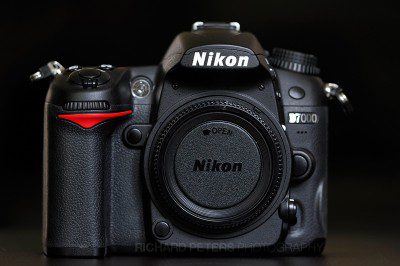
The Nikon D7000, it\’s may be small, but packs a mighty punch.
Nikon released the D7000 effectively as a replacement for the D90, but as everyone said right from the day it was announced, it basically jumped in as what most considered the companies flagship DX DSLR (a title still held until the arrival of the official D300s – but even given that, I still wouldn’t overlook this great little camera). Sure there are a few things missing to make this a true Pro camera, but on paper and after several months of use I can honestly say this really is a much better camera to use than the D300(s), let alone the D90.
OVERVIEW
Resolution: 16mp DX sensor, 4928 x 3264
Speed: frames per second (11 shot burst in 12bit RAW, 10 in 14bit)
Focus motor: New 39 point autofocus system
Video: 1080p HD with autofocus
More info: On the Nikon website
I’d also like to say thanks to Nikon & the guys at the official I AM NIKON BLOG for loaning the camera for review.
Where to buy:
B&H Photo video in the USA. Warehouse Express & Clifton Cameras in the UK
LETS BEGIN…
Ok, so lets get on with this! And as we start I’ll just explain that this review is based on my own experiences, and how I’ve found the camera to operate and perform in real life situations. As such, you won’t find me talking in extensive detail about every single feature on the camera, as this isn’t a technical review, it’s more an account of my thoughts after prolonged real life use. As such I hope this review comes in handy not only for those looking to move up the Nikon DSLR family tree, but also those who are looking for a small, light backup DX camera to a full frame system. After all, there is no denying when it comes to wildlife photography, the DX crop factor for those harder to reach subjects is something that’s hard to resist!
Ever since I had a quick hands on with the D7000 when it was launched, I wanted to shoot with it in real life situations, so when the kind folk at Nikon asked me if I’d like to test one for a while I jumped at the chance! I received it just before I went out on a two week winter wildlife trip to Yellowstone National Park in the USA, and opted to take just the D3s and D7000, leaving my D300 at home. A brave move, given I had no real experience of the D7000 other than what I’d read about it, but I was confident in its abilities. And I was right in doing so as it performed perfectly whilst I was there, even shooting without flaw when the temperature dropped to -39f!
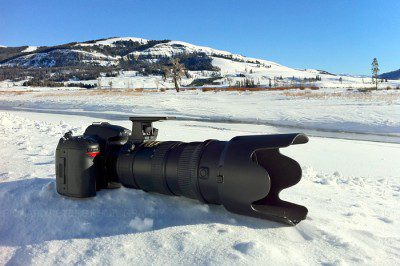
Even in the biting cold of Yellowstone, the D7000 didn\’t miss a beat
After returning I used it quite a bit in the UK, in all weather ranging from bright sunny spring days to dull, grey and wet typical British days. I also took it with me on a two day trip to The Farne Islands. At times I’ve even left the D3s at home and forced myself to use the D7000 to really get an understanding of how it performs. I really enjoyed the experience, but it wasn’t perfect, so I’ve highlighted not just the good points but also, what I considered to be weaknesses. But remember, these are MY thoughts for my shooting style, and is only to help give you an idea. What is a flaw for me could be irrelevant to you.
BUILD AND CONTROLS
The D7000 is small. Very small. In fact, I’ve got quite small hands but even I was surprised at how small it felt to hold. Unfortunately I wasn’t supplied with a grip for testing so it really was quite an experience getting used to a small body form again. My D300 grip never came off and of course the D3s is a large beast, so the D7000 on initial handling felt almost like a toy. My second impression quickly arrived, and that was how solid it felt in the hand and how well designed it felt, with the major buttons all being within easy reach. My third impression was that I didn’t like the way some of the features and buttons were organised. At first I wondered why no dedicated ISO, quality or White Balance buttons and why those buttons also served dual purpose with other features. I also wondered how on earth I change between the focus modes until I found the little button round the front, and realised this, in conjunction with the command dials, was what I was looknig for. But then I had to remind myself, this isn’t a pro camera and that there will be some differences in control and layout. But that just goes to show what a great camera this is, that at times you forget it isn’t here to replace a pro body, but a high end consumer body.
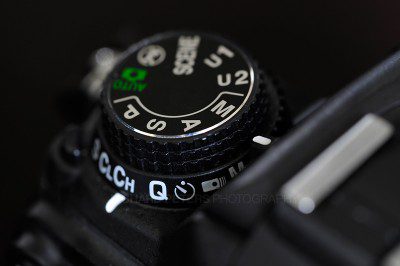
A more \’grown up\’ mode dial, borrowed from bigger cameras
The dual rotation mode dials and SD card slots also help give the camera a ‘grown up’ feel, akin to it’s bigger brothers. The mode dials are especially welcome as they make switching between different shooting modes quick and easy when you’re out in the field. There is a user programmable U1 and U2 modes on this dial, and they are great for setting up different sets of settings, should you need to switch from one shooting style to another very quickly. The dual SD cards are great for shooting stills to one and video to another, or of course using card two as backup or overflow.
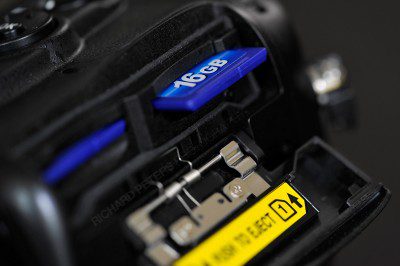
Although SD, the dual card slots are very welcome
Overall the button layout and nice large buttons make the D7000 a pleasure to use, and once you get passed the slightly quirky controls for a few select features it becomes fairly easy to operate without taking your eye from the viewfinder. My only real problem here is the main mode dial, where as the sub mode dial for selecting shooting speeds, timer etc has a lock, the main one does not. On more than one occasion I’ve found myself wondering why the image I just took didn’t come out right, or why the focus mode has changed, only to realise I’ve accidentally switched to another shooting mode and not realised. Not a huge problem, but something that has happened several times, which is enough for me to notice.
However, I’ve had no qualms about shooting in adverse conditions with the D7000 and even when caught out in a massive snow storm in Yellowstone, I carried on shooting with snow settling quite thickly not just on me, but the camera and lens (my 70-200 VR) as well. But still it didn’t miss a beat.
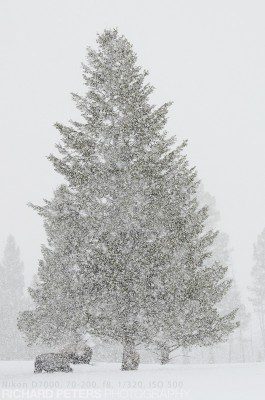
Blizzard. D7000, 70-200, 1/320, f8, ISO 560
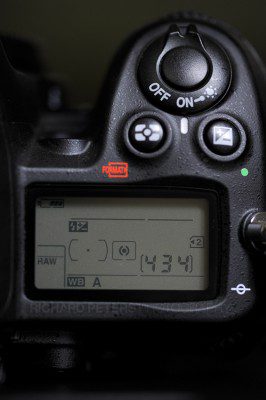
Top LCD provides usual info at a glance
Having said above how surprised I was at just how small the D7000 is, one place that came in very handy was on the way home from Yellowstone. I needed to make some room I my hand luggage and was able to squeeze the D7000 in my jacket pocket, freeing up valuable space in the bag! So if you need to travel light, this would be a very attractive bonus to the size.
WILDLIFE PHOTOGRAPHERS, SILENCE IS GOLDEN & THE DX EFFECT
Ok, so it’s not silent in operation, but the already very quiet D7000 offers a Quiet Shutter mode, and although this reduces the frame rate down to one shot per second, it is very very quiet. This is great news for wildlife photographers, as there are times when you are in a hide or other noise sensitive situations, and even the camera firing can spook the subject.
The other added bonus to this camera is of course the DX crop factor. This is like having a 1.5x a teleconveter always attached to the lens. It doesn’t actually give you a boost in focal length of course, but what it does is give you the same field of view as a longer focal length, effectively allowing you to get more pixels on your subject. So my 600 VR effectively becomes a 900mm, my 200-400, a 300-600.
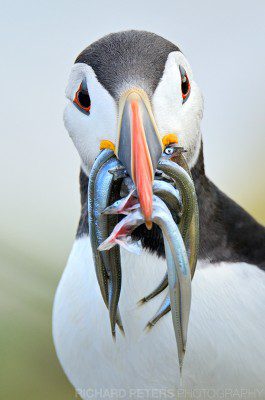
D7000, 600 VR + 1.4x TC
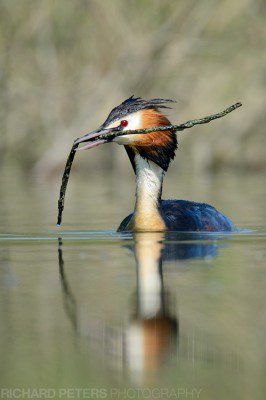
GC Grebe: Nikon D7000, 600 VR, 1/1000, f5.6, ISO 200
As you can see, once you start adding teleconverters, you really see some impressive reach when you look through the viewfinder, and that is what really attracted me to this camera! Getting back the DX crop factor, but in a camera body that inspired confidence and offered the image quality to do it justice.
IMAGE QUALITY
The D7000 has been around long enough now that there are many many image quality tests all over the net. In fact I did my own high ISO test back when it first came out, comparing it against the D300. So check that out for some side by side comparisons. What I really want to talk about here however, is the quality in the real world, because that is where it really matters. I was never a huge fan of the D300(s) image quality. It was ok, and I got some lovely shots with it at times, but it never left me overly excited. A lot of users really rated the ISO performance whereas I personally thought it was a bit hit and miss. The D7000 however is a very different beast. Now don’t get me wrong, there is still noise present and it does progressively get worse as the ISO creeps up, but as I’ve been looking back over my images recently I’ve had the same ‘wow, that’s really that high an ISO figure’ feeling for some images that I first had when I picked up the original D3 when it first hit the shelves. That’s not to say the D7000 is on par with the D3 or D700 because it’s not, but in real world use I’ve found it far more pleasing than the D300. Detail seems to be held for longer and the noise has a much more pleasing fine grain look to it, with nasty coloured blobs from chroma noise being far better controlled.
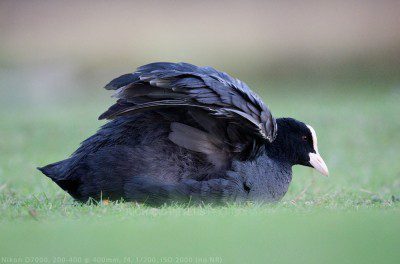
D7000, 200-400, f4, 1/200, ISO 2000 (no NR)
What I will say though, is exposure is absolutely the key to clean higher ISO images with the D7000. On the full frame cameras you can underexpose a little and still get away with good clean high ISO images but I’ve found the D7000 is a little less forgiving and pulling detail out of the shadows can very quickly become an exercise in fighting off noise. Get the exposure pretty accurate though and you’ll be rewarded with surprisingly clean images. Of course, your idea of what noise is acceptable will be different to mine, but for me, once I notice the noise before I notice the actual image, that’s when it becomes a problem.
Here is a 100% crop taken at ISO 1100, at f4, 1/200. That’s my absolute bottom line for handholding the 200-400 at 400mm on a crop sensor. There has been no processing done to this at all, just a simple conversion to jpeg and saved for web. It may be slightly soft due to the shutter speed v focal length, but it gives you an idea of what to expect with a good exposure. I used this image specifically because of the dark feathers in the bird, as it’s dark areas that’ll show up the noise faster.
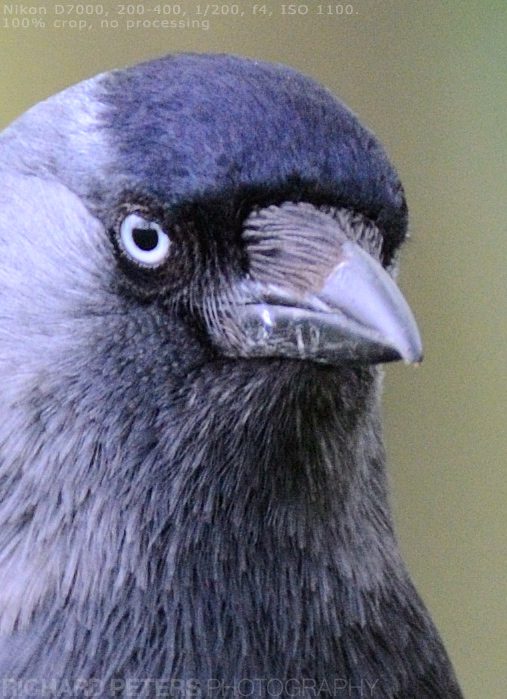
unedited 100% crop at ISO 1100, 1/200, f4
Personally, I’ll happily shoot the D7000 up to ISO 1600 providing a I can get a good exposure for it. If I can’t, I’ll go higher to ISO 3200 but then I know I might have to do some work to clean the image up (I’m not a fan of noise reduction, so try to avoid it if I can). Remember though, I’m saying this as someone who’s main camera is a D3s. If I was moving up through the ranks of DSLRs then I’d be less critical and appreciate the ISO performance of this camera far more.
MORE RESOLUTION = GET GOOD OPTICS AND PRACTICE TECHNIQUE
One thing I have noticed right away with the D7000 is that all those pixels in such a small space will start to show up any flaws in your lenses and lens holding technique faster. That’s not to say the D7000 makes your lenses look rubbish, but it’s certainly less forgiving. And with all those pixels packed tightly, it really does require you paying attention to your technique before you press the shutter. Much the same as when the 12mp D2x first hit the shelves many years ago. There were wide reports from photographers on many forums that it was soft, but in fact it was just that you really needed to be that bit more careful in reducing vibration before firing the shutter. The jump from 6mp to 12mp caught people off guard, and the same thing can happen here if you get lazy.
A QUICK MENTION OF VIDEO
1080p and full time auto-focus show that Nikon has starting to pick their game up in an attempt to catch up with Canon, who are, lets face it, way ahead of the game when it comes to video in DSLRs. I’m still just finding my feet with video, so don’t really feel I can talk too much about the pros and cons but I can certainly give you my thoughts so far.
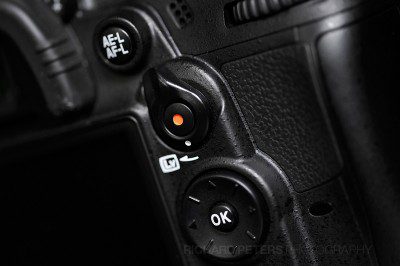
Dedicated Live View switch and Record button are welcome
What I can tell you is although the auto-focus has several options to configure it, I don’t think it’s very reliable as it twitches all the time if you are moving the camera or anything in the scene is moving around. I’m sure someone out there may find it’s usable for something, but I personally much prefer the good old method of manual focusing for now. Although I welcome the day focus in video is good enough to track a bird flying! Also, you can really tell Nikon are thinking more and more about video just from the way it is activated. It was a breath of fresh air to have a switch I could flick with my thumb to initiate live view, followed by a nice red record button in the centre of that flick switch. Compared to the separate, and not next to each other, method of the D3s live view and record buttons, the D7000 really feels like it was always built with video in mind which is nice.
I also did a very quick rolling shutter test way back when I had a first hands on, so I’ll just stick that here again so you can see it for yourself. But to sum up, yep, there is still rolling shutter problems.
The biggest downer for me so far though is that the camera has no full manual mode for video capture. You can set the shutter and ISO when live view is on but the aperture can only be changed when live view is off. There is also no visual exposure meter on the screen so you can’t get an idea of the video exposure when recording. That’s fine as you can use the LCD for quick reference but if there is bright sun or tricky light you may wish for that exposure meter on screen to give some assistance.
I’ve since been informed that if you have a D or manual lens (i.e., a lens with an aperture ring), as apposed to the more modern aperture ring-less G lenses, you can set it up as a non-CPU lens with the camera and this allows you to have full manual control in video. It’s not really a hack, but given the camera by default with modern G lenses doesn’t allow you to have full manual, it’s more of a hidden feature, but handy to know!
Clips out the camera are nice enough though and open up in both CS5 and iMovie with no problem, although I’m still hoping for something better with the next generation of Nikon DSLRs as far as video in concerned.
FOCUS
I’m definitely impressed with the focus speed from the new 39 point AF system. It’s done a good job of focusing on near and far subjects and even been quite happy to track a Red Kite doing it’s aerial acrobatics when I’ve been shooting with the 600 VR with both the 1.4 and 1.7x TC’s. If nothing I’d say it’s on par with the D300(s).
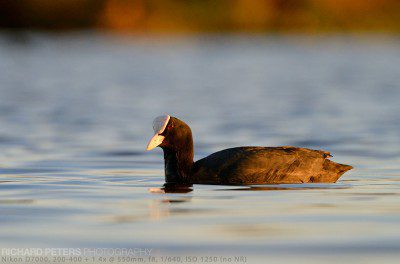
D7000, 200-400 + 1.4x TC, f8, 1/640, ISO 1250 (no NR)
What I have noticed though is the focus can be twitchy sometimes and eager to switch to another subject or micro-hunt if the light is too contrasty or the subject is a bit jittery. Also, if the light is very poor it can have a bit of trouble locking on at times. This is made even worse if you are trying to hand hold at longer focal lengths. This is probably more noticeable for me because I’m using the D7000 alongside the D3s, which has rock solid focus. But it’s certainly something I’ve become aware of at times. For example, if there is an animal on the ground or bird in a tree obscured by grass/branches, the D7000 can have a hard time pin pointing where the subject is, if only a little of it is showing. In contrast, with the D3s, if I get a focus point on even a small part of the subject, it doesn’t matter whats in the way, the D3s will lock straight on.
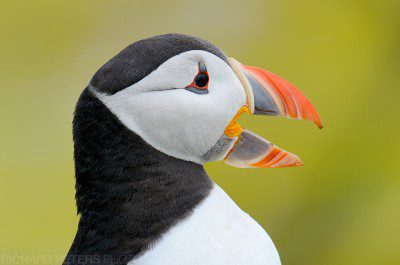
Nikon D7000, 600 VR, 1/400, f7.1, ISO 160
The good news though is that it will still focus in regular conditions until light levels drop off enough that your average keen amateur will probably have stopped shooting anyway because of the lack of light. And for the Pro or serious hobbyist, if you’re shooting this camera as a backup to a full frame camera, you’ll want to switch to that anyway once it gets too dark to make use of the better ISO. I’ve read some reports that said the D7000 (at the time of release) had the best focus system of any camera out there, better than even the D3s. It doesn’t. But it’s very impressive, and if you work within the limitations it will reward you with some very sharp images!
BATTERY LIFE
Very good! I was worried it would run out quickly, especially when I was in well below freezing temps in Yellowstone, but it never came close and I would always have at least 60% remaining in the evening. Quite impressive, given the harsh conditions. Of course battery life is hard to judge as it varies depending on how many shots you take, what the camera settings are, how many video clips you film etc. But to date, I’ve never even come close to worrying about needing a spare battery whilst out shooting – which is handy, as I didn’t have one anyway!
CONS: WHAT I DONT LIKE AND WHY
Ok, so we’ve covered the main parts of the camera and what I’ve thought about them. It’s mostly good but there are some problems that I’ve found over the last few months shooting with this little DX beast. Whether you see them as problems will depend on your needs but these are based on mine:
I’ve already mentioned this but it’s tiny and light. I have quite small hands for a man but even I was surprised at how dinky it felt to use. The size and weight might be an advantage to many out there, but if you are like me and shoot with big heavy lenses it does feel a little uneasy. I’ve never felt like I could potentially break a lens mount before on a camera until I connected the D7000 to my 600 and 200-400. I know you shouldn’t do this anyway, but sometimes I pick these lenses up briefly by the camera first. Well, not with this little D7000 I won’t. It suddenly feels quite delicate when connected to these robust telephotos. Shooting with the 200-400 I found it quite unbalanced and had to get my mono-pod out as even just walking around the combo felt slightly uneasy due to the weight of the lens overpowering the build of the camera. Adding the battery grip is supposed to improve on this unbalanced feeling though, but I can’t comment directly on how much so.
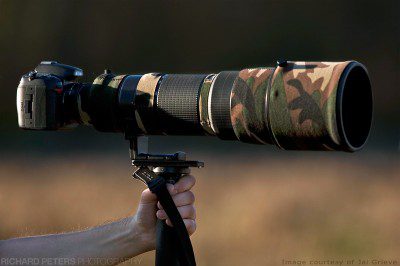
The D7000, mounted to the 200-400 VR with a 1.4x TC
It’s only fair however, that I also point out that I was able to test the D7000 out with the Sigma 150-500, which Warehouse Express sent me to review, and with that type of lighter lens the D7000 shines. After all, not everyone who uses a D7000 is going to have £5k+ of lens to attached to the front. And paired up with a more modest lens, you get a very light and powerful combination that I found a breath of fresh air, especially as I usually have over 7kg of gear to carry around with me!
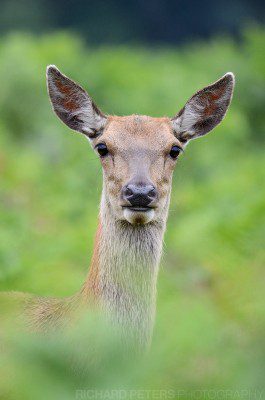
Paired with the Sigma 150-500, great lightweight setup
The buffer and speed. If you are buying this camera to shoot anything fast paced such as sports or certain types of wildlife, be warned, the camera can only fire off ten 14bit RAW files at 5 frames per second, or eleven if you shoot 12bit RAW. The biggest problem is the speed it takes to clear the buffer, coming in at roughly 15 seconds, but that’s with a class 6 SD card, so that might improve nicely with a faster card. Regardless, a bigger buffer would be most welcome. As it is, it’s slow, very slow. And whilst 15 seconds may not seem like a long time, if there is something going on it front of you, waiting for that buffer to clear can feel like an eternity! I’ve since been told with a Class 10 SD card, the buffer clears in 10 seconds, which is a big improvement
10 Pin connection. It’s very easy to forget this body is not designed to be a mini Pro camera given how well it presents itself overall, but one of the things that reminded me was the missing the 10 pin terminal for accessories. I’ve got several shutter release cables and remote shutter cables, none of which I can use with this camera.
That main mode dial. Like I said before, it’s easy to twist it to another shooting mode without realising. I’ve done it several times and think it could do with being a little stiffer.
SD cards. If, like me, you are already heavily invested in Compact Flash cards, having to buy in to a new set of cards is a pain.
And as an aside, the grip isn’t compatible with the EN-EL4a battery. Not a big deal, but I loved the D300 because I could shoot two cameras and only needed to take one battery type and charger when I travelled.
FINAL THOUGHTS
As you may have gathered I think this camera is good. Very good. It’s not without it’s little issues and quirks granted, but I’ve been shooting it as a backup to one of Nikon’s flagship cameras which will naturally make it easier for any shortcomings to be noticed. But the fact I’ve enjoyed using it so much alongside the D3s is a real credit to the ability of this camera. I think once the D400 or whatever the true D300s replacement is called, arrives, we will be in store for something very special indeed as I have no doubt all these little quirks will be ironed out.
But the D7000 has performed without issue in all kinds of weather and condition and it’s been a joy in every single situation. I’ve never had to stop and think if I should take it out the bag, regardless of the conditions I’ve been shooting in, or felt like I had to baby it. And that’s a very good thing indeed. After all, if you can’t trust a camera, you wouldn’t want to shoot with it!
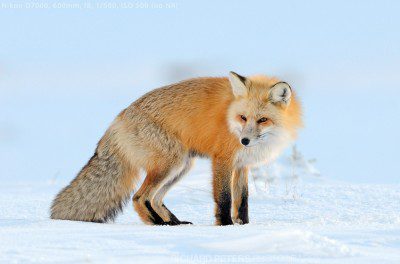
Red Fox, Yellowstone. D7000, 600 AFSII, 1/500, f8, ISO 500
So would I recommend it? Without hesitation, in fact 3 of my wildlife photographer friends have purchased them as backups after me raving about it to them! I myself sold my D300 soon after getting this loaner, and I certainly didn’t pester the good folk at Nikon to take it back from me in a hurry!
The only exception to an instant recommendation to buy, is to those who need more speed from a camera. The extra resolution is certainly nice but because of where this camera sits in the Nikon family tree it comes at a price, that price is speed. However, if you already have a fast shooter and simply need a DX backup camera for getting some extra reach, or you are looking to upgrade to a slightly higher spec camera than some of the lower end entry level models, then you simply can’t go wrong.
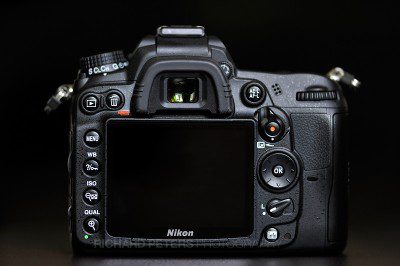
The rear button size and layout, akin to it\’s bigger brothers
So to sum up this review, although the Nikon D7000 certainly isn’t able to claim Pro status within the top end of the Nikon DSLRs, for the price, it does a very good job at trying to keep up with them!








